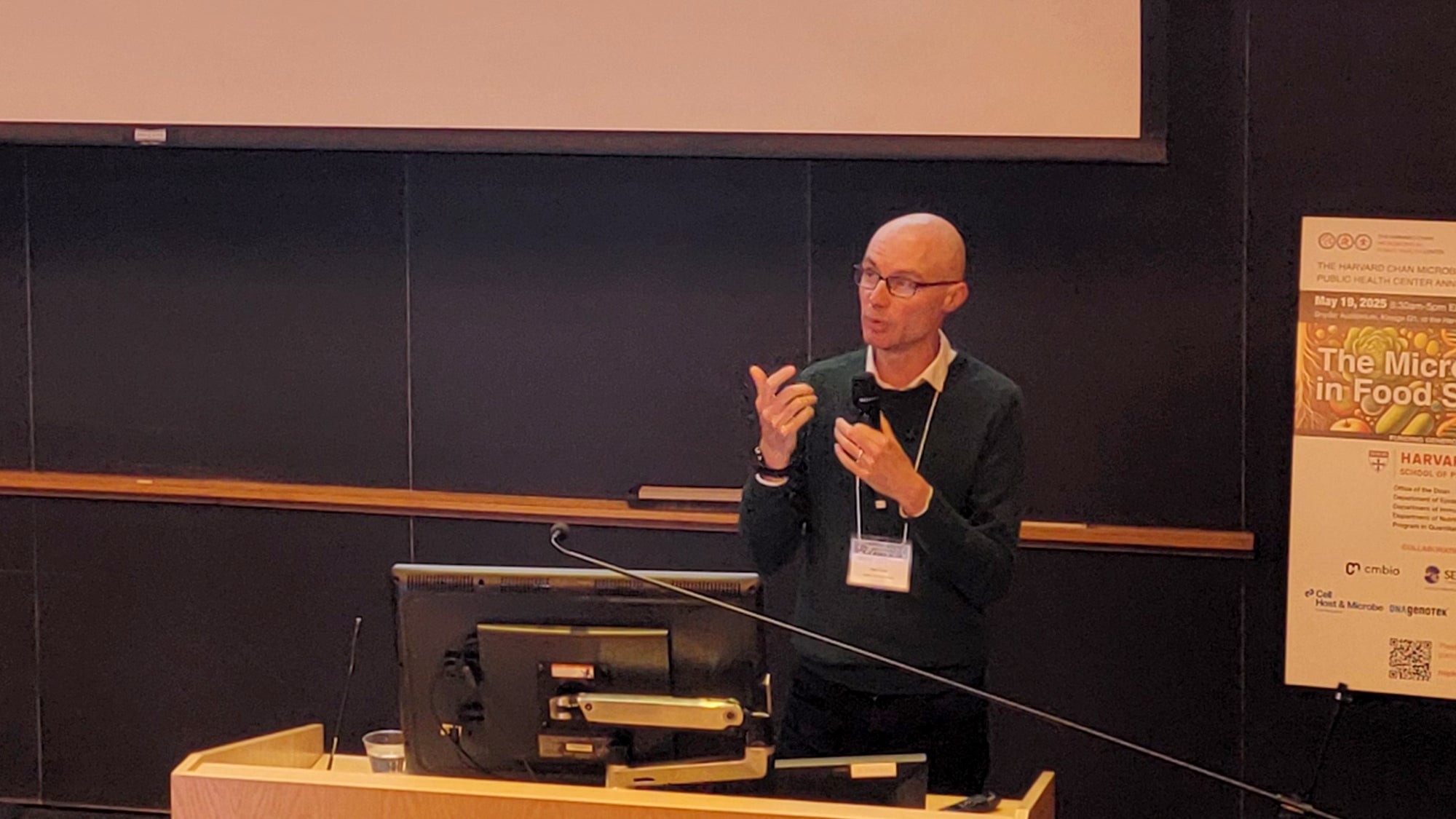Role of microbiome in food system explored at symposium

Since 2021, around 21,000 people around the world have taken part in the “Blue Poop Challenge,” which involves baking and eating muffins that contain an unusual ingredient—blue food dye. Afterwards, participants track how long it takes for the muffins to be digested and turn their poop blue—all in the name of microbiome science.
“The intention of this campaign … was to really get people thinking about the importance of gut health, thinking about the importance of the microbiome—but more importantly, not being squeamish or embarrassed about talking about their poo,” said Sarah Berry, nutrition professor at King’s College London, speaking at the 7th annual symposium hosted by the Harvard Chan Microbiome in Public Health Center. The May 19 hybrid event was held at Harvard T.H. Chan School of Public Health.
Berry and her colleagues created the campaign based on their previous research, which showed that when stool took longer to pass through the digestive tract, it contained a higher diversity of microbial species. She said that the dye method is a relatively simple measurement that could be used to study the effects of different diets on the microbiome, which may in turn be associated with health outcomes such as cardiovascular disease.
At the symposium, speakers focused on the wide range of roles that the microbiome plays throughout the food system—from cow milk production to food fermentation to people’s diets—which could ultimately influence human health. The symposium also featured a panel of industry experts who discussed the opportunities and challenges of commercializing microbiome science, as well as a trainee poster session.
Understanding the milk microbiome
Erika Ganda, assistant professor of food animal microbiomes at Pennsylvania State University, shared her research on dairy cows, motivated by the fact that agricultural, human, and environmental health are all interconnected.
“The glue that actually keeps all these things together are the microbes,” Ganda said.
One study by Ganda and her colleagues focused on bovine mastitis, a bacterial infection of dairy cows’ mammary glands. Livestock producers typically treat the disease with the antibiotic ceftiofur, but overusing the drug could lead to bacteria becoming resistant to it—potentially making the antibiotic less effective if it needs to be used in people.
In the study, the researchers infected cows with E. coli, one type of bacteria responsible for bovine mastitis, and then measured how the microbiome of the cows’ milk changed over the course of infection. The researchers found that infection reduced the diversity of bacterial species in the milk. But then, regardless of whether the cows were treated with ceftiofur or not, the microbiome recovered to its normal state within the same amount of time. The study concluded that livestock producers may not need to treat cows with antibiotics in order for the animals to recover and produce healthy milk again.
Paul Cotter, head of the Food Biosciences Department at Teagasc in Ireland, also presented his research on the microbiome of cow milk. In one study, he and his colleagues took milk samples from farms around Ireland over the course of a year, analyzing them using high-throughput sequencing—a technique that sequences DNA and matches the results to the genomes of different microbes. The researchers identified multiple factors—such as the season of milk collection and geographic location—that affected the types of bacteria present in the milk, including ones that cause spoilage or mastitis.
“Eventually we might get to a point where you can almost predict, on the basis of seasonality and other practices, what your milk microbiome might be,” Cotter said. The information could help livestock producers understand the quality of their milk, he added.
Microbiomes through the food system
Cotter said that he uses similar sequencing methods to study other aspects of food microbiomes. For example, he and his team collected microbial samples from different surfaces in a pork processing plant, such as equipment and tables—and found antibiotic-resistant bacteria that could have been transferred from pig carcasses. Cotter and his colleagues have also investigated how microbiomes affect cheese quality and the health benefits of the fermented drink kefir.
“Advances in high-throughput sequencing, new databases, and other developments are giving us new insights into the microbiomes of food systems,” he said. “This knowledge can be used to enhance the safety, quality, and health-related aspects [of food].”
Harvard Chan School speakers at the symposium included Jacob Nearing, a postdoctoral research fellow in the Department of Biostatistics, and Walter Willett, professor of epidemiology and nutrition, who gave opening remarks.